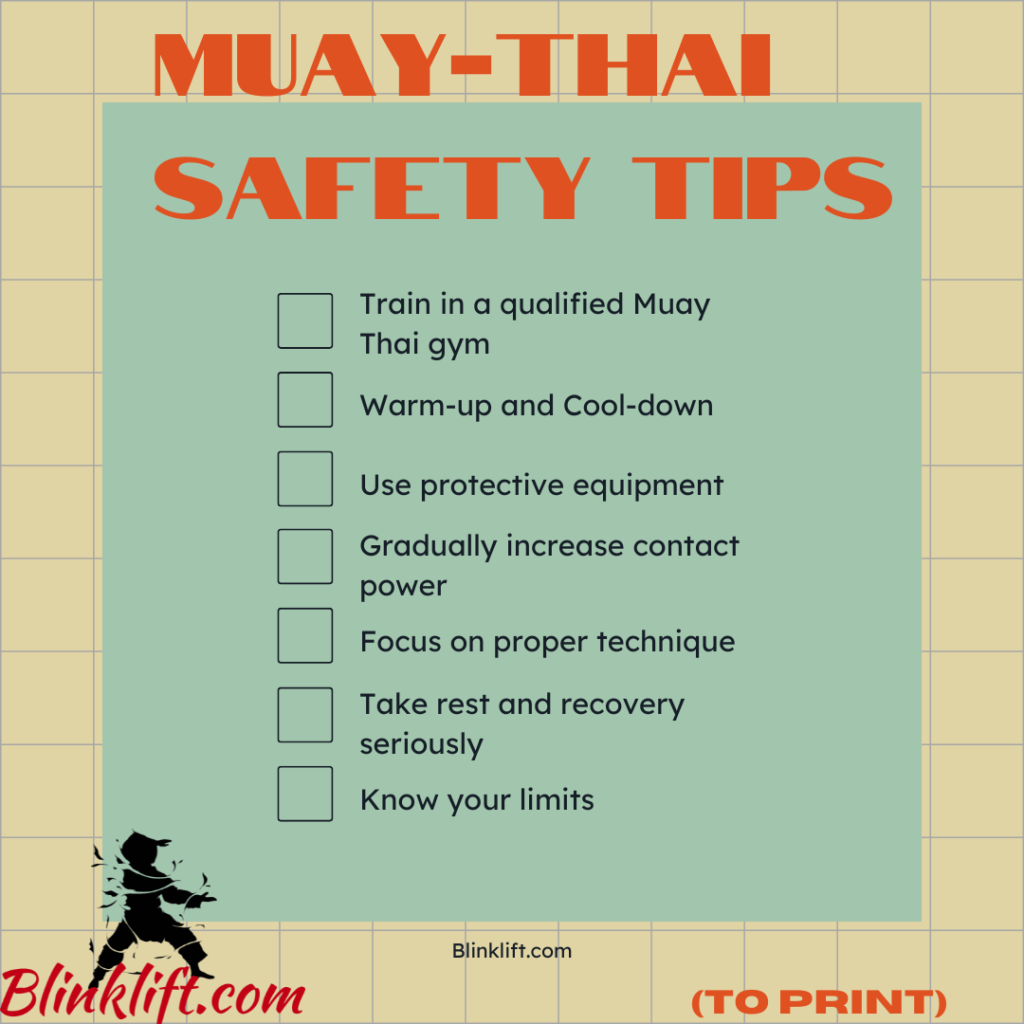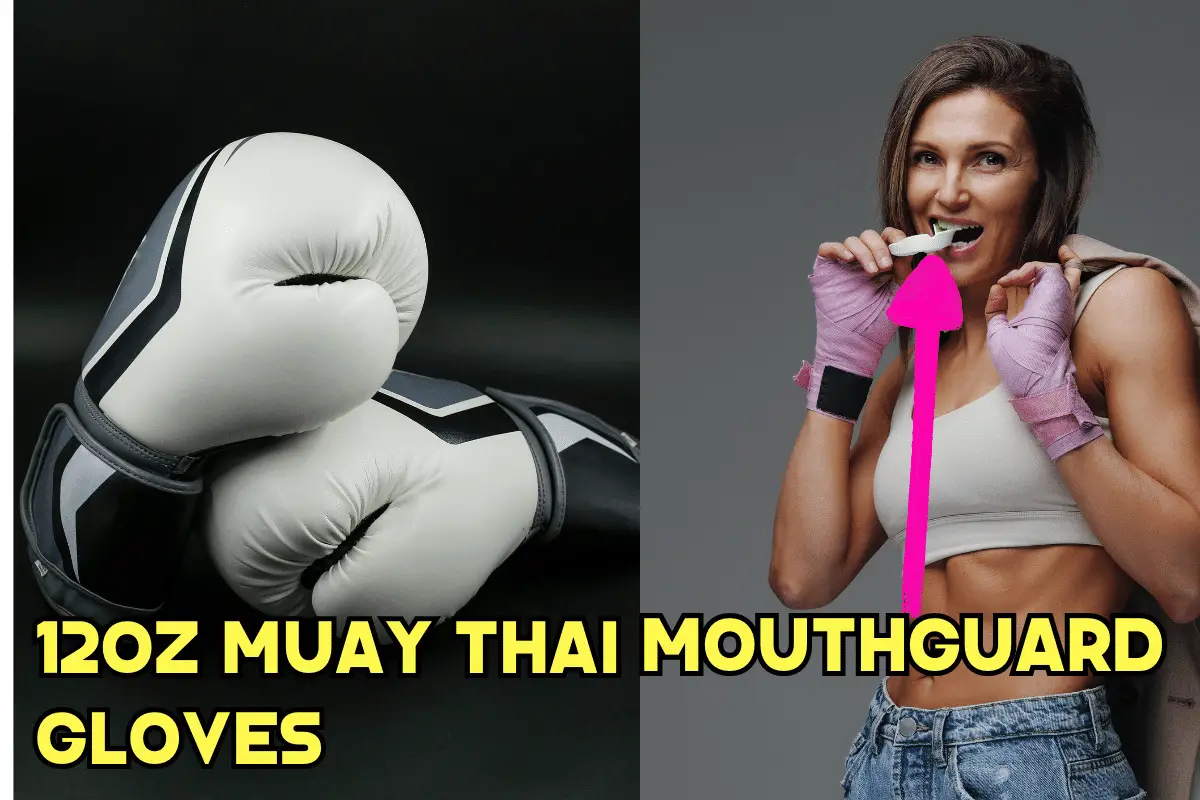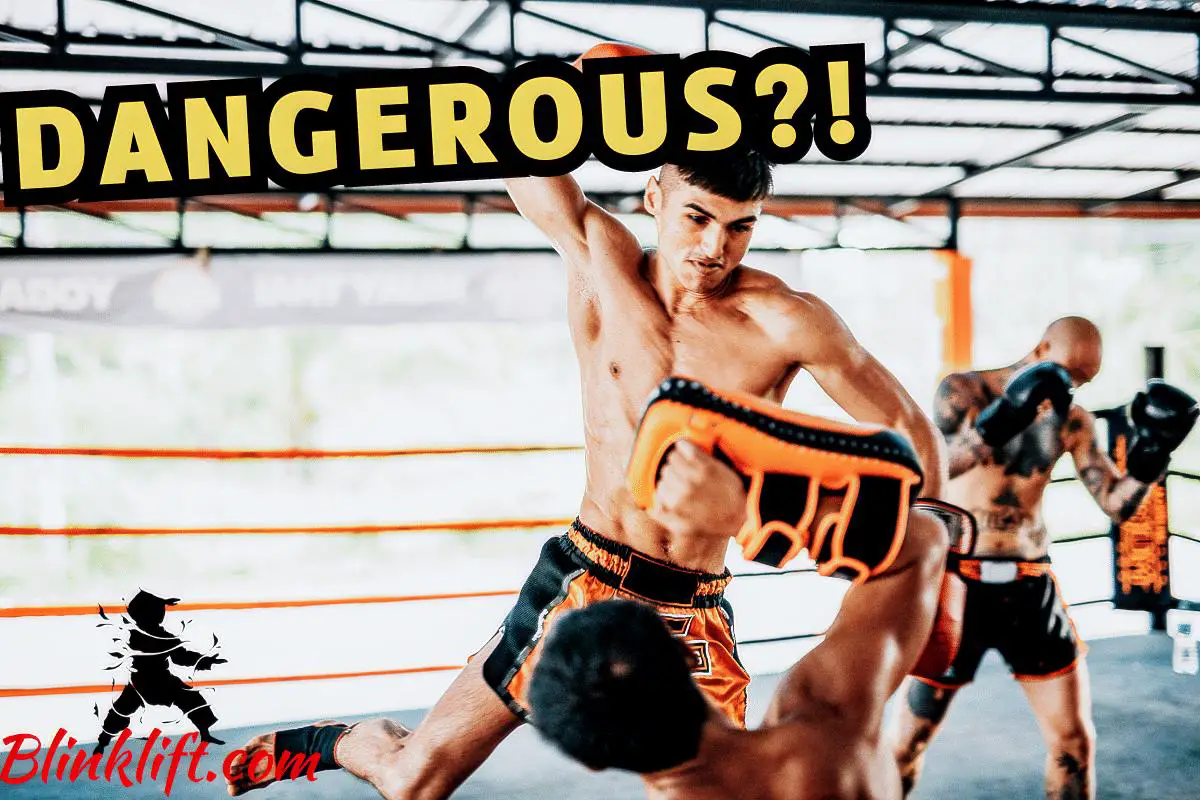Combative sports are naturally more dangerous than other physical activities. When you put two fighters who specifically train all day to learn how to fight another person and tell them to fight each other, there are going to be various injuries involved. Muay Thai is one of these combative sports, considered to be unsafe. However, is it really?
Muay Thai is a dangerous combative sport and martial art to do regularly, as it involves striking and grappling techniques in full contact. The most commonly used techniques in Muay Thai are punching, elbowing, kicking, and kneeing. Furthermore, it embraces aggression and pain endurance, making it even less safe.
So let’s say you want to learn Thai Boxing, aka the art of 8-limbs, but are hesitant due to the fact that it’s an unsafe sport. In that case, I have something to tell you. What we’ll do in this article is list out tips you must implement into your training. Now, if you implement all of them regularly, the likelihood of you stepping out of your Muay Thai gym injured—greatly diminishes.
Yes, you will experience pain. And yes, Muay Thai will be intense and difficult to stick with. However, the number of valuable benefits you’ll receive from consistently attending Muay Thai training—is unheard of.
So now, let’s dive into the first section of this article. In it, we’ll dive deep into why Muay Thai isn’t as safe as other sports. And, because that’s the case, we’ll also cover how we can greatly lower the risk we take in classes.
Is Muay Thai Safe to Learn?
Indeed, Muay Thai, aka Thai Boxing, is a full-contact combative sport that embraces aggression through striking. It’ll teach you how to fight like an animal. However, because that’s the case, there’s great risk attached to training. Let’s see whether it’s safe to learn.
Muay Thai, like any combat sport, carries inherent risks and can be physically demanding. It involves striking techniques using fists, elbows, knees, and shins, as well as clinching and grappling maneuvers. As a result, there is a potential for injury during training and competition.
However, with proper training, safety precautions, and supervision, the risk of serious injury can be minimized. Muay Thai training typically involves learning proper techniques, conditioning exercises and supervised sparring sessions. Qualified instructors prioritize teaching proper form and technique to reduce the risk of injuries.
This is all true. With a qualified instructor, you’ll be able to reduce the risk you take on yourself when you step into the Muay Thai gym. I won’t lie, you’ll go through full-contact drills that will ensure you experience some level of physical pain and fear. I mean, getting punched right in the face isn’t a pleasant experience, to say the least.
So now that you know that Muay Thai is a dangerous combative sport, I want to dive into ways you can prevent injuries and boost safety in your training. Please don’t think that safety tips are only for dorks or people who don’t know how to fight. They’re not. The best professional fighters in the world ensure to implement these tips, as they know how dangerous sparring and fighting can get.
Let’s dive in!
Safety Tips for Muay Thai
Alright. You’re now on the practical side of this article. This part is critical to ensure you’re not getting any injuries whatsoever from your Muay Thai training.
Know that the training session was NOT worth it if you stepped out of the gym injured. I myself have experienced back and neck injuries due to training BJJ and Muay Thai, which is a long story. But still, I’m now incapable of training and I have to rest for more than a week. This disables my options and doesn’t allow me to progress.
Remember, if you step out of your Muay Thai gym with injuries that prevent you from attending the next training session, it wasn’t worth the effort and the training session.
We can take precautions to ensure we don’t injure ourselves while doing Muay Thai. What we’ll do now is dive into seven ways you can and should implement to prevent injuries in the national martial art of Thailand.

#1 – Train in a qualified Muay Thai gym
The first step relates to where you’re training. You want the place you learn and fight at to be qualified and to have instructors who (1) know what they’re doing and (2) not prioritizing fighting over safety.
Choose a Muay Thai gym or training facility that has experienced instructors who prioritize safety and proper technique.
You’ll immediately spot the difference between an instructor who prioritizes safety and one who does not. When you push yourself beyond what the instructor thinks to be your limit, he’ll point that out to you. This is contrary to what many instructors, who prioritize progression and pain, will do.
The first step is to choose a proper and qualified Muay Thai facility and coach.
#2 – Warm-up and Cool-down
The second tip is to ensure you warm up and cool down. This is an especially critical step if you want to avoid joint injuries and muscles being sore or overtrained.
Always begin your training sessions with a proper warm-up routine to prepare your muscles and joints for physical activity. Similarly, end your sessions with a cool-down period to help your body recover.
I have yet to stumble upon a Muay Thai gym that doesn’t have a solid warm-up before diving into the more vigorous training, such as full-contact sparring. You will be doing pad work, heavy bag training, and shadowboxing before you get into sparring.
If you train alone, either at home or on the heavy bag in your gym, make sure to start slowly and amp up the pace once you feel your body is warm. You want to gradually use your muscles, as that’ll help you prevent short and long-term injuries.
Three of the studies found that performing a warm-up prior to performance significantly reduced the injury risk
SOURCE
The same applies to a cool-down after you’re done with the training session. Here’s a solid warm-up I found that’ll help you prevent injuries and recover better.
#3 – Use protective equipment
The next tip is, I believe, the most important one on this list and the one that’ll have an immediate and significant impact on the likelihood of injuries in your Muay Thai journey. This tip is to use protective equipment all the time, without giving up using them ever.
Wear appropriate protective gear, such as hand wraps, gloves, mouthguards, shin guards, and headgear. These items are designed to reduce the risk of injury and should be used during sparring and heavy bag training.
Wearing protective gear will be necessary for proper progression and injury prevention. If you currently think that you’ll do Muay Thai without wearing gloves or a mouthguard, think again. If you don’t use either one, you’ll end up injured and unable to train. This is the worst thing that can happen to your Muay Thai career, as you’ll have to sit on the sidelines for a long period.
I wrote the ultimate guide on the necessary protective equipment you must have to train in Muay Thai safely. Likewise, most Muay Thai gyms won’t allow you to train without having such equipment. That means that you’ll get it at some point in your journey, so make sure to read the guide for the best gear out there.
What’s important here is not the fact that you have to buy such equipment for the gym, but it’s for your safety. Once you understand that, you’ll want to get your hands on such equipment and invest in your safety.

#4 – Gradually increase contact power
Gradually increasing your contact power has two primary benefits to it. First, it disables you from the opportunity to punch improperly. That means that when you’re a beginner, your punches and kicks aren’t as solid yet, which is entirely natural and just the way it is.
So, when you punch slowly, for example, you lower the risk of injuring your hand and wrist, compared to when you punch with 100% of your power.
Secondly, if you’re an advanced trainee, you want to start the training session slowly and amp up the pace once you’re warmed up. The slow punching and kicking will help your body warm up for the current training session, which is what you precisely want.
As a beginner, start with light contact and gradually increase the intensity as you gain more experience and confidence. This allows your body to adapt and reduces the chances of sustaining injuries.
#5 – Focus on proper technique
Focusing on honing your technique to be flawless, whether it’s punching or kicking, is what your next focus should be. If you’re able of throwing a flawless punch, you’ll diminish the likelihood of you getting hurt.
Pay close attention to your instructor’s guidance and practicing proper technique. Strive for accuracy and control in your strikes, kicks, and defensive maneuvers. This not only improves your performance but also minimizes the risk of injury.
This is exactly the reason why beginners should get heavier gloves. The heavier gloves include more padding and can absorb more impact. Therefore, beginners will benefit more from them and the safety they include.
Once you have honed your technique to a point where you 100% trust your punching technique, you can lower down the weight. That’s why advanced trainees will find the 8-12oz gloves more suitable.
Now, I wrote a complete Muay Thai glove sizing guide that I encourage you to read if you don’t know what size is suitable for YOUR personal needs.
#6 – Take rest and recovery seriously
Overtraining is one of the primary injuries athletes experience. We all know how enjoyable Muay Thai is. As a result, we want to do it every single day, which can actually hinder your progression.
While you might learn and practice the techniques more, your body will find it hard to keep up with the intensity you’re putting on it. What will happen as a consequence of your muscles not keeping up with your intensity is a state of overtraining.
Allow your body enough time to recover between training sessions. Overtraining can increase the risk of injury and hinder progress. Listen to your body and take breaks when needed.
Here are some of the most common symptoms of overtraining:
- Unusual muscle soreness after a workout, which persists with continued training.
- Inability to train or compete at a previously manageable level.
- “Heavy” leg muscles, even at lower exercise intensities.
- Delays in recovery from training.
- Performance plateaus or declines.
Listen to your body and take sufficient breaks between training sessions..
#7 – Know your limits
Be aware of your physical limitations and do not push yourself beyond what you can handle. Avoid reckless behavior, and if you feel any pain or discomfort during training, communicate it to your instructor and seek appropriate medical attention if necessary.
This is where I failed in my previous training session. We all know how attractive and fulfilling it can be to complete a martial arts class, especially Muay Thai. In that case, we might push ourselves too much to finish the class.
What will end up happening is that because you push yourself way beyond your limit, you’ll overtrain and hinder your long-term progression.
If you don’t currently know what your body is truly capable of, begin slowly and amp up the pace when you feel you’re ready for more strain and pressure. My body’s limit is way beyond what I initially thought it was. Therefore, I began understanding what it was only after I started my Muay Thai training.
Pay attention to your body’s limit and you’ll lower your injury risk, both in overtraining and fighting-related injuries.
Final Words
I’ve had a good time researching and writing this article because I was injured in the last training session I attended. Before the session, I did a complete Back workout in the gym, which put on my back a lot of pressure and pushed me over my limit, which was fine if I had simply gone home after the training session.
However, my Muay Thai session was coming up and I was eager to fight, so I forgot all about the slightly uncomfortable back pain I was feeling. The Muay Thai session actually went well. However, what I realized the day after a long night of rest is that I pushed myself way beyond my body’s limits. As a consequence, I now have to rest for more than a week (from all physical training) to return to normal.
You want to avoid these instances from happening, which you can do by following all the tips I have mentioned in this article.
If you enjoyed this article, here are other articles you’d enjoy reading:

